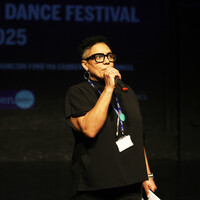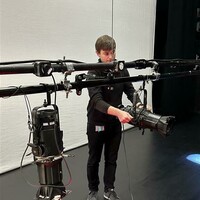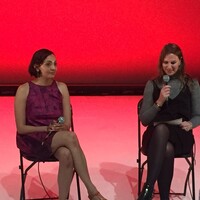Restaging Cunningham's seminal Event

News Story
In September 1972, Merce Cunningham staged the seminal dance Event in Piazza San Marco, Venice during the 35th International Music Biennale. To mark the Event’s 50th anniversary and celebrate Cunningham’s legacy, another Event will be reimagined in a collaboration between the Biennale Archives, Biennale College and The Cunningham Trust. This site-specific performance will feature repertory from Cunningham’s body of work, and will be shaped by restagers Jeannie Steele and Daniel Squire, who were dancers in the Merce Cunningham Company. We sat down with Jeannie, who has been on the faculty here at London Contemporary Dance School since 2007, to speak about staging this new Event.
Jeannie Steele spent sixteen years working with Merce Cunningham Company, beginning as an apprentice and then joining the company as a dancer and rehearsal assistant. Since 1998, Jeannie has been a senior stager and has restaged Cunningham’s work in many ways, mounting his choreography on a number of companies including Pacific Northwest Ballet, Royal Swedish Ballet, New York City Ballet and Rambert.
These experiences have given Jeannie a close proximity to Cunningham’s approach, technique and vocabulary. “I’ve been very much invested in learning and teaching his material and it’s been part of my entire relationship with his work for many years.” Staging this new Event at the Venice Biennale marks another opportunity for Jeannie, along with fellow restager Daniel Squire, to reimagine Cunningham’s work once more.
“This is the 50th anniversary of Event which was originally performed in the Piazza San Marco (St. Mark’s Square) in 1972, a hugely special performance at the time,” says Jeannie. “The performers were wearing trackies and trainers, they had chairs which they used to carve a performance space. They also had work around all the pigeons! It was quite marvellous for the Italian public to see this spectacle in their piazza.”
“Venice Biennale director and The Place Patron Wayne McGregor recognised the importance of this moment in dance history and wanted to reimagine it," says Jeannie. "The 2022 rendition will of course be different as it’ll take place in a different location within the festival’s physical space. But the impact of the 1972 event in St Mark’s will still be felt and will most certainly come through in this restaging,” Jeannie continues.
Venice Biennale director and The Place Patron Wayne McGregor recognised the importance of this moment in dance history and wanted to reimagine it.
Jeannie Steele
Jeannie explains that what’s so interesting about the site-specific format is that it enables Merce’s work to live on. “Site-specific work is always about being and dancing in the moment,” says Jeannie. “One time we did a work in Perth on the beach and beyond the thousands of people watching in the distance, bathers in the sea were bobbing up and down watching the performance. Another was in the Baalbek Festival in Lebanon where we were dancing in the Temple of Jupiter among the ruins. Every evening the musicians would stop for the Muslim call to prayer. It was magical and resulted in moments you’d never experience in a conventional theatre space.”
When it comes to restaging such a seminal event, are there any pressures to be as faithful to the original? “In terms of the legacy, it’s not so much about holding on as it is letting go,” says Jeannie. “Whenever new people came into the company, Merce was always really wonderful about letting that new person inhabit the work as themselves, and not asking them to be like the person they were replacing. I think that’s one of the great gifts he gave to us as a choreographer as he wasn’t fixed on this idea of how something should look or be. The steps are the steps, but the person is what enlivens them,” she continues.
“As a stager and knowing Merce as I did, I’m conscious that I don’t want the work to be an exact replication of the original Event,” says Jeannie. “I want the Biennale dancers to investigate the work and the steps as they are and bring themselves into the restaging. That’s the way the work really lives – you’re not trying to replicate, you’re reconnecting with a new body.”
Jeannie highlights that rather than the audience going to see a piece by Cunningham, what people will see is the work in a new environment with new costumes, music and people. “It reinjects life into choreography that is 50-60 years old,” she says. “That’s probably the thing I love most about it,” she smiles.
So, what will the 2022 reimagining of the 1972 Event look like? “Merce’s pieces are about a community of people coming together to do something, they’re not based on narrative,” Jeannie says. “Merce made the steps, and Daniel and I will be teaching them. He and I will have to decide what the flow of this hour-long piece will be, what the dancers will be doing and when. We’re essentially making a collage out of Merce’s work. There’s a choreographic sensibility to it without it being choreographic.”
“We’re going to choose material from an entire repertory from different eras – which is no mean feat!” says Jeannie. “But we can use the archives and Merce’s notes to shape the event. Merce was a true visionary, and I think he’d be very intrigued to see where the restaging goes…”
The restaging of Event will take place on 31 July at this year's Venice Biennale. For more information about Event visit here.


